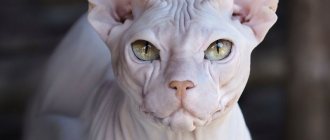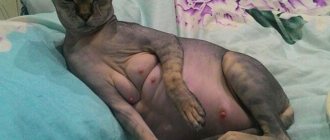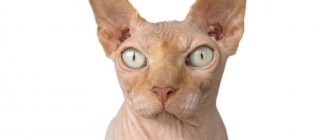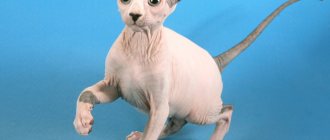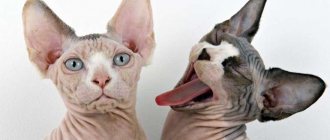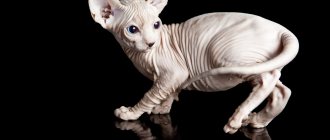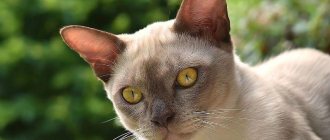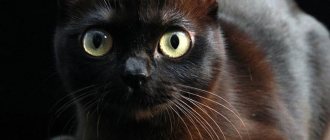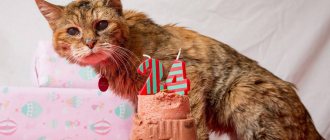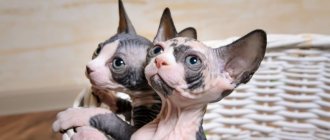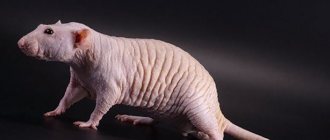The Canadian Sphynx is not just an unusual cat, she is different. The mysterious creature attracts attention, surprises and makes you ask many questions. The absence of hair on suede leather and a deep, piercing gaze will not allow anyone to pass by.
Surprisingly, sphinxes have several varieties of color and even mustaches. These mystical animals are loving, loyal friends for their owners, and require special care and attention.
History of the Canadian Sphynx breed
Canadian Sphynx
Although the breed is quite young, the existence of hairless cats is mentioned in the annals of various civilizations. The thing is that “bald” offspring can appear from completely ordinary parents as a result of a natural mutation. Most often, such animals were considered an anomaly and were discarded by humans.
There is evidence of the emergence in South America of an entire population of graceful creatures with amber-colored eyes. True, unlike Canadians, they could be partially covered with wool during the cold season, and wore mustaches all year round. It is impossible to judge the genetic characteristics of these animals today, since the breed has disappeared. The last individuals whose existence is documented lived in the 20s of the last century, but then “Inca cats,” as the Mexicans called them, did not interest professional breeders.
40 years have passed, and much further north, in the Canadian province of Ontario, the owner of a black and white short-haired cat named Elizabeth was surprised to find an unusual specimen in her pet’s litter. The kitten was given the name Prune (English: Prune) and, upon reaching maturity, was crossed with its own mother. The first experiments seemed successful, but already in the early 1970s the line was interrupted.
Around the same time, a new stage in the history of the breed began. In one of the catteries in Baden, Minnesota, two cats were devoid of fur at once. All modern elite lines trace their pedigree back to them, although the selection process, of course, included cats of different breeds. The best results were achieved by working with Devon Rexes; “naked” kittens, which were again discovered among our northern neighbors, actively participated in the creation of the breed. They were originally called “Canadian hairless cats,” but enthusiasts wanted something more sonorous and drew parallels with the oldest surviving monumental sculpture - the Egyptian Great Sphinx, which guards the peace of ancient rulers in Giza.
Recognition from international felinological organizations did not come immediately. There were concerns that the mutation was causing serious health problems. When time showed the inconsistency of these theories, The International Cat Organization (TICA) was the first to allow Sphynx dogs to participate in its exhibitions in 1986. After 6 years, champion status was received from the Canadian Cat Association (CCA), but the breed standard according to the authoritative The Cat Fanciers' Association (CFA) was approved relatively recently, in 2002.
Rare colors
In conclusion - less common colors, but allowed by the standard.
"Siamese" (color point)
Kittens are born light, almost white. But as they grow older, a dark “mask” appears on their face, their paws and tail turn black. The eyes remain bright blue.
"Mink"
The baby is also born light-colored, but with age “puts on a coat” - platinum, blue, striped, cream, blue, champagne.
"Sable"
Another suit that develops towards adulthood. This is a rich dark sable color without spots, darkening, oh
The animal's skin is a warm copper, beige tone. The color is clean, without inclusions or
The skin is pale gray, silver. There are no stripes or blotches.
Appearance of the Sphinx
Sphynx kittens
Sphynxes are not among the large breeds. Females usually weigh 3.5-4 kg, males weigh between 5-7 kg. At the same time, the body is muscular and dense, which is why cats actually turn out to be heavier than one might expect given their size. The skin is thick and gathers into characteristic folds, especially pronounced on the muzzle.
Head
Medium in size, shaped like a slightly rounded modified wedge, where the length is slightly greater than the width. The forehead is flat, the transition from it to the muzzle can be either quite soft or clearly pronounced. The muzzle is short. The cheekbones are high and clearly defined. The chin is strong and forms a perpendicular to the upper lip. The nose is short, with a slight to medium stop. The whisker pads are well developed, although the whiskers themselves are completely or almost completely absent.
Ears
Ears are one of the distinctive features of the Canadian Sphynx breed. Very large compared to the head. Upright and open. The base is wide. The inner surface is without wool.
Eyes
The eyes of sphinxes are large, shaped like a lemon, because with a wide middle part they narrow equally on both sides. Set wide and slightly slanted. The color is not regulated, but must be in harmony with the color.
Neck
Medium length, slightly arched, with well-developed muscles.
Face of the Canadian Sphynx
Body
Sphynx paws
The body of the sphinx is of medium length, muscular. The chest is wide and rounded. The belly is round and full. The back of the body is rounded.
Legs
Medium length, proportional to the body. Strong and muscular. The hind ones are slightly longer than the front ones.
Paws
Oval, with thick pads and well-developed long toes.
Tail
White Sphynx
The length of the Sphynx's tail is proportional to its body. Graceful and flexible, gradually tapering from base to tip.
Cover and skin
The skin of the Canadian Sphynx is thick and forms folds, which are especially numerous on the face and legs. They seem completely hairless, but usually the body is covered with delicate down (a length of no more than 2 mm is allowed). The norm is the presence of short, sparse hair on the outside of the ears, tail, between the toes and in the scrotum area. The bridge of the nose is covered with the usual short hair for cats.
Color
Despite the lack of hair in the usual sense, sphinxes have many colors: white, black, red, chocolate, lilac (lavender), tabby, tortoiseshell, two-color, calico (tri-color), color point, mink. Neither conflicts with the CFA standard.
Breeding
Now Canadian Sphynxes are gaining popularity, more and more nurseries and breeders are appearing. Finding a partner for mating is not difficult, especially in large cities. In almost all millionaire cities there are places where you can buy a purebred specimen. There are especially many of them in Moscow and the region.
Mating
This is a complex process that must be organized at the proper level. It is important to create the right conditions for this to happen correctly. Puberty in Canadian Sphynx cats begins at one year of age, and the first estrus begins at 6 months. Cats begin to mark at about one year of age.
Pregnancy
The female's pregnancy lasts 62-68 days, 65 days on average. In some individuals it can last 58-70 days. During this period, the cat should have increased nutrition and increased feeding frequency. The cat should receive a portion of food 20-30% larger than usual, and the frequency, instead of two, should be increased to 4-5 times a day.
Nursing Sphynx cat with kittens.
Castration and sterilization
The operation is performed on males and females and lasts from an hour to three. The operation is performed under general anesthesia. If the owner does not plan to breed the breed, it is recommended to carry out this procedure in order to save the animal from physiological and psychological torment.
Photo of the Canadian Sphynx
Who is not recommended to start
Canadian Sphynxes are quite unpretentious animals and can find the key to the heart of any person, however, there are features that you need to pay attention to before buying a hairless baby.
- Allergy . If you suffer from an allergy to cats, then even a hairless pet will not save you from it. In most cases, the allergen is cat protein, which is found in saliva, sweat and feline waste. And Sphynxes sweat all over their bodies, unlike other breeds!
- Lack of time for care . The need to bathe your pet weekly will raise serious doubts for some people. If you want a cat that doesn't require any maintenance, then the Sphynx is not for you.
- Frequent absence from home . Sphynxes are attached to their owners, so a prolonged absence of human communication is always stressful for the pet. You should not choose a Sphynx as a pet if you lead an active lifestyle outside the home.
The character of the Canadian Sphynx
The ancient sculpture of a lion with a human head, lost in the African sands, was once called differently by Arabic speakers - Abu al-Haul, that is, the Father of Terror. But her little namesakes don’t seem at all intimidating to their owners. These are real “tails” that will follow a person everywhere and will not miss the opportunity to settle on his lap.
This sphinx has found its place
However, such affection is not at all an indicator of laziness. Sphinxes are very mischievous and playful creatures; they get involved in active fun with great excitement or independently come up with entertainment for themselves, such as “hunting” for a beetle that happens to be in the apartment. Games should be versatile and challenge not only dexterity and muscle strength, but also the intellect.
Sphinxes do not tolerate loneliness well, which should be taken into account by potential owners whose work involves frequent and long business trips. Canadians are attached not to a place, but to “their” people, so separation is a difficult test for them, even if in your absence the care of your pet is entrusted to reliable and kind hands.
Sphynxes are absolutely not aggressive, so they get along well with children of different ages and calmly share their home with other pets. Moreover, they know how to be friends with both cats and dogs, which helps brighten up the long hours of waiting to meet a person.
Representatives of this breed get used to being in large crowds of people quite easily. Thanks to this, sphinxes feel good at exhibitions, and some bring the skill of equanimity to such a level that they become real movie stars. The most striking example of this is Ted Nugent, who played the role of Mr. Bigglesworth, Dr. Evil's cat from the famous Austin Powers film series.
"Chintz" (Calico)
An interesting group that is united by the predominance of white (mainly on the lower part of the body). The suit is complemented by various variations:
- White with black and red spots gravitating towards the head, limbs, and tail.
- White with cream and blue spots.
- White with blue and blue spots on the head, legs, tail.
Group of suits "chintz":
Care and maintenance
Having no hair may seem like a big advantage to a busy owner, but in fact, Sphynx cats require even more care than their furry counterparts. The sweat and sebaceous glands in these cats work in “normal mode”, so a kind of plaque forms on the surface of the skin, which provokes the appearance of greasy stains on the owners’ clothes, bedding and upholstery.
Canadian Sphynx in a sweater
To avoid this, hygiene procedures should be carried out regularly. Some people think that it is enough to wipe the cat’s body with wet wipes that do not contain alcohol or fragrances. But most agree that the optimal solution to the problem is weekly bathing with special mild products or baby shampoo. If you accustom a kitten to them from an early age, the process will happen quickly and without much hassle. Please note that immediately after a bath the sphinx must be wrapped in a towel!
The issue of hypothermia is generally quite acute for representatives of this breed. When you hold a hairless cat in your arms, it seems really hot. The fact is that due to the lack of a fur “buffer”, heat exchange with the external environment is much more active in them than in other animals. This means that in a cool room the sphinx will freeze no less than a naked person, so buying special clothes for winter and the off-season will not be superfluous even for permanent residents of city apartments.
By the way, experienced breeders recommend exclusively keeping Canadian Sphynxes at home. If you consider it necessary for your pet to stay in the fresh air, it is better to limit its duration and monitor the cat at all times. Independent walks are contraindicated not only because of the risk of colds or sunburn (yes, Sphynx cats can get tanned and burn, so in the summer they need sunscreen!). Thanks to its characteristic appearance, even a layman can easily recognize your pet as a purebred, which means a potentially expensive animal, which can lead to kidnapping.
We didn't find a house and organized it ourselves
Other care tips differ little from the standard ones. It is important to monitor the condition of the eyes and ears to avoid infections. Regular brushing of your teeth with a special paste guarantees protection from tartar, and trimming your nails will help keep your furniture and walls in their original condition.
The cat will be grateful for a personal “house” with the opportunity to climb higher and play hide and seek, but most sphinxes prefer the owner’s bed, where you can comfortably sit under a warm blanket, to a soft bed.
All sphinxes have an excellent appetite. This is another side effect of not having fur, as they require more energy than other cats due to their intense heat exchange. The main thing is that the quality of the food is at a high level and fully satisfies your pet’s needs for proteins, fats, carbohydrates, vitamins and minerals. The easiest way to achieve this balance is with specialized premium and super premium food. But if you are willing to spend time creating a healthy menu of foods, natural nutrition will be a worthy alternative.
Leftovers are sweet
Canadian Sphynx having a meal
Tortoiseshells
This group of colors of the Canadian Sphynx is characterized by a coloring reminiscent of a tortoiseshell - black, cream, red specks and spots. The nose and paw pads are also motley.
Turtle cinnamon
The main tone is cinnamon. The specks are darker or red.
Turtle "lavender"
On the skin of a delicate lavender tone there are dark lavender, creamy inclusions.
Turtle cream
The main color is fawn. A darker cream or fawn “shell” runs along it.
Tortoiseshell color of sphinxes:
Health and illness of the Sphinx
Cute sphinx
In general, with the right diet and proper care, sphinxes are infrequent patients of veterinary clinics. Problems can be caused by hypothermia, prolonged exposure to the sun, neglect of hygiene rules on the part of the owners, and lack of immunity due to missed vaccinations.
But there are also breed-specific diseases. The weak point of Canadians is sensitive skin; it can be affected by urticaria pigmentosa. Redness and rashes on the body can also be symptoms of allergies, including food allergies. Only a doctor can determine the exact cause and prescribe treatment based on test results.
Like Maine Coons, Sphynx cats suffer from hypertrophic cardiomyopathy. This dangerous heart disease is caused by a genetic mutation, but to date there is no convincing evidence that heredity has a decisive influence on its development.
But another disease of sphinxes, myopathy, is transmitted to descendants from parents. They got it in the process of selective work with Devon Rex. Progressive muscle dysfunction has no cure, progresses individually and often leads to death as a result of laryngospasms. Usually appears at 4-7 weeks of age, but may be asymptomatic until 12-14 weeks. The nursery must warn you if the kitten is at risk.
Bicolor
The main feature of this category is a uniform combination of spots of only two colors on the animal’s body. Various options with white are allowed:
- Any color with white.
- Tortoiseshell and white.
- Striped and white.
How to choose a kitten
The main advice is the same for all purebred animals: do not try to save money on your purchase by going to the “bird market” or responding to a random ad. Only the best nurseries and breeders with an impeccable reputation will guarantee that you will receive a healthy pet, the origin of which cannot be doubted. After all, the Canadian Sphynx is not just a lack of hair, but a graceful, beautifully built, affectionate and intelligent creature that will live next to you for the next few years.
If you do not plan to participate in exhibitions, it is enough to make sure that the chosen baby is healthy and active, easily makes contact with people, without showing fear or aggression. The rest will be determined by the available documents (pedigree, veterinarian’s report, vaccination card). We recommend getting to know the parents and looking at the living conditions - they will say a lot about the breeder’s attitude towards the cats.
Plain
The category includes solid colors - the body of the animal is painted in a single color. For Canadian Sphynxes, several variations are allowed here.
White
The animal's skin is clean, shiny, and has a delicate whitish-pinkish tint. There are no stains or inclusions. The nose, paw pads, and lips are pink.
Black
The skin is painted a uniform black color. White spots, tan marks, and “ties” are not allowed. Paw pads and nose are black or dark brown.
Black cat:
Blue
Uniform color from nose to tip of tail. Looks like silver or light gray. The animal's pads and nose are dark gray.
Red
The animal's skin is shiny, evenly colored in a soft red tint. There are no marks or stains. The lips and eye rims are the same color as the entire body. The nose and pads are brick red in tone.
Cream
The color of the Canadian Sphynx can be compared to the color of buffalo skin. The nose and paw pads are pink.
Cream Sphynx:
Chocolate
Cat skin has a rich brown, chestnut color. Nose, paw pads - cinnamon tones.
Lavender
The correct description is frosty gray with a delicate pinkish “highlight”. The nose and pads of such a cat’s feet are dark pinkish and lavender.
"Fawn" ("faun")
A very interesting color - fawn, soft beige with a pink tone. The cat's paw pads and nose are also light fawn.
"Cinnamon" (cinnamon)
The color of the animal’s skin resembles a shade of spice – rich brown. The nose and paw pads are also cinnamon-colored.
Sphinx color "cinnamon":
Photo of the Canadian Sphynx
Required vaccinations
| Age | Vaccine |
| 6 - 8 weeks | Vaccination against panleukopenia (FPV), rhinotracheitis (FVP), calicivirus (FCV) |
| 12 weeks | It is advisable to conduct an ELISA test. If the result is negative, the leukemia vaccine (FeLV) is given, and the FPV, FVP and FCV vaccines are also given again |
| 16 weeks | Rabies Vaccine, another booster against FPV, FVP and FCV and a booster against FeLV |
| 15-16 months and then annually | Vaccinations against FPV, FVP and FCV, FeLV and rabies |
| Vaccination against pneumonia (FPN) is necessary if there are many cats in the house or the Sphynx lives in an area unfavorable for this disease |
How much does a Sphynx cost?
If you are offered to buy a Sphynx kitten for 3-4 thousand rubles, you can rest assured that there can be no talk of any pedigree here.
The price of kittens in trusted nurseries starts from 8-10 thousand rubles. Children who have more or less significant deviations from the breed standard are cheaper. They are perfect for those who dream of a pet with an extraordinary appearance and character.
Prospective exhibitors whose parents can boast of championship titles and other titles will cost their future owners at least 15 thousand rubles.
"Tabby"
On the animal’s legs there are visible “necklaces” on the neck. The tail is also “ringed”. On the forehead the stripes form the letter “M”. A bizarre butterfly-shaped pattern spreads from the eyes along the cat’s cheeks. There are uniform stripes throughout the body.
The color variations of "tabby" are largely the same as solid colors. The animal’s body may have silver, lavender, fawn, brown, blue, chocolate, red, cinnamon, and cream spots.
Silver tabby
There are black markings on a cold silver background. Lips and chin are earthy in color.
Brown tabby
The main tone is copper, brown. There is a black pattern running across it. The chin, eye rims, and lips should be the same color. Hind legs - with black heels.
Blue tabby
The main shade is silver, pale gray. A more saturated blue pattern runs along it - the contrast is visible to the naked eye.
Red tabby
The main tone is warm soft red. The pattern is rich red.
Cream tabby
The main shade is pale soft cream. The pattern is buff color or a richer “cream”.
Chocolate tabby
Available in two varieties:
- Chocolate chestnut. The skin is a delicate, warm fawn color. There is a rich chestnut pattern running along it.
- Chocolate silver. The main tone is grayish with a cold metallic tint. It has chocolate-colored markings.
Cinnamon tabby
Again two variations are allowed:
- Cinnamon tabby. The main tone is light honey. The pattern is a rich cinnamon color.
- Cinnamon-silver tabby. The main color is metallic, “shiny silver”. Decorated about.
Lavender tabby
Breed standards also allow two varieties:
- Lavender tabby. The skin tone is pale lavender with a pinkish tone. The markings are a rich lavender (gray-lilac) hue.
- Lavender-silver tabby. Background color – cold milky, “transparent silver”. There is a darker lavender pattern running across it.
Fawn Tabby
The main shade is “ivory”. The pattern on the animal's skin is fawn, yellowish-brown.
Tiger type "Canadians":
Nutritional Features
Sphynx cats are not too picky about feeding. They can eat green peas and fresh tomatoes. By nature, these are real gluttons and owners must adhere to certain rules when preparing their diet. Otherwise, symptoms of obesity or digestive system disorders will appear quite quickly
Cats should be fed 3-4 times a day, paying special attention to foods rich in vitamins. Every day the animal needs 200 grams of protein, and carbohydrates - half as much
If the owner feeds his pet with ready-made food, then for these purposes it is worth purchasing high-quality dry or canned premium products. Fish products should be limited in the Sphynx diet or given boiled once a week. The following products are strictly prohibited for these animals:
- onion;
- potato.
Sphynxes benefit greatly from rice and buckwheat porridge, especially with the addition of a spoonful of vegetable oil. The basis of the menu is fermented milk products, but sweet, fatty and fried foods should be excluded.
From the meat assortment, it is recommended to give preference to:
- raw or boiled lamb and beef;
- raw minced chicken giblets.
Cottage cheese is a welcome dairy product, but milk itself should be given only to kittens, gradually reducing its presence in the diet until it disappears completely. Milk is contraindicated for adult animals. Your diet should also include fresh vegetables and fruits.
Hygiene
Don Sphynxes have some features:
- The Donetsk people are sweating. Everything.
- Their skin secretes a protective brown lubricant called pectin. But it does not pollute the skin with proper care.
- Sphynx cats, like other cats, groom themselves. But there are places that are difficult or impossible for them to reach: the tummy, muzzle, neck, etc. They need especially careful care.
Based on all these features, Sphynx skin care is as follows:
- The Sphinx is bathed once a month; if the skin gets dirty faster, you can bathe it once every 2 weeks.
- Every day the skin of the sphinx is wiped with a natural cloth (linen, cotton) soaked in a special caring lotion or warm water.
- For bathing, use natural soft shampoo and a gentle sponge. One of the 3 baths is done with a cleansing antibacterial shampoo for Sphynxes.
- In winter, Donchak needs insulation (clothing), and in summer - protection from the sun (for example, special cream or light clothing).
Photo gallery: which shampoos are suitable for the Don Sphynx
Ms. Kiss “Graceful Sphynx” is suitable for all hairless cats. Elite for hairless breeds gently cares for the skin of the Sphynx.
Doctor Vic shampoo for hairless breeds Royal Groom Care and Moisturizing is suitable for all hairless animals
Care for claws, teeth, eyes, ears
Comprehensive care for the Don Sphynx is as follows:
- Ear care. To do this, you will need cat ear cleaning lotion, cotton swabs, and cat ear cleaning drops.
- Clean your ears once every 5 days. Drops are placed inside for cleaning, and the base of the ear is massaged for a minute or two.
- Then the auricle is wiped with a swab dipped in lotion.
- You will need: a piece of natural fabric and lotion to clean the eyes.
- To care for your teeth you will need a silicone toothbrush (if your cat has weak gums, it is better to take a piece of natural fabric) and cat toothpaste.
- You will need a nail clipper.
Interesting Facts
- Sphynxes completely destroy the well-known myth that cats hate water. Hairless cats are avid water swimmers . The main thing is that the water is warm.
- They are excellent jumpers . Young sphinxes easily conquer a height of 1 meter, and for adults, even a 3-meter height will not be an obstacle. Therefore, it is unlikely that you will be able to hide something from the sphinx on the closet.
- In ancient times, hairless cats were considered a sacred animal.
- Sphynxes are true models of the cat world. They love to pose so much that every guest in the house, in their opinion, comes to look at the spectacular handsome man. American photographers have repeatedly noted that the Canadian Sphynx is one of the most photogenic breeds.
- This is the most human-dependent breed. In natural conditions, sphinxes will not be able to survive, since they do not have natural “radars” of danger - vibrissae.
The Sphinx can become a full-fledged member of the family. Although he needs special care, his affection and devotion make up for this many times over. Plus, there will never be wool in the house or on clothes. Do you like Canadian Sphynxes? Leave your feedback in the comments, let's see how many of our readers are bald lovers.
Source
